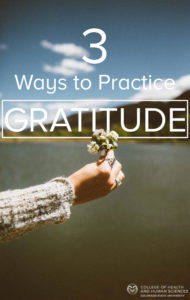Mindfulness and other practices in self-reflection have been around for a while, but sometimes they can be intimidating small changes to make. It is easy to feel like these practices are not adding much to daily life because they do not often result in physical changes like exercise might. However, these practices have been proven to impact overall health, particularly related to psychological well-being.
Remember that which benefits the mind also benefits the body.
By practicing gratitude, you become more aware of positive events, you’re more resilient in the face of negative experiences, and you can improve your social support systems. Of 88 older adults asked to express gratitude with three positive experiences a day for 15 days, it was found that there was a measurable increase in reports of thriving and a decrease in perceived stress. Other research supports that regular practice of gratitude can predict a decrease in feelings of loneliness, too.
Practicing gratitude doesn’t just benefit mental health. There are physical benefits too that can result from these improved mental outlooks and decreases in perceived stress and loneliness. Gratitude practice has been shown to lower blood pressure and cholesterol levels, along with improving sleep and immune function. These changes in gratitude practice may help individuals make other healthy life choices, changing behaviors and overall health.
Ways to practice gratitude
- Write down one to three moments a week (or day) of positive experiences that you are grateful for. It is easy to start with big picture areas like: “I’m thankful for my family,” but with time, start to dig deeper to small joys in your life such as: “I really enjoyed that my favorite song came on the radio on my drive to work.” Aim for quality over quantity in writing down the things you are grateful for and don’t forget the people in your life. You can write down your interactions with them, or feel free to let them know when you are grateful for them.
- Avoid going through the motions when possible. Combine gratitude with mindfulness to enjoy the experiences of the current moment you are in. It is easy to get in the trap of running through previous events and how they went wrong or planning ahead, but taking a pause during good and joyful moments can really help to carry through to future experiences. The pause can also create a better and stronger memory of the experience, and lets you realize the moments that are truly bringing joy to your life.
- Consider helping causes important to you. Whether it is a donation of your money, time, or talents, getting involved in matters that are important to you will help with gratitude. It will help you appreciate the work that other people do and it will help you to appreciate your own time too.
Negative moments can be far easier to focus on and tend to sit with us longer, but with practices in gratitude, hopefully many can come to realize how many positive moments are happening all the time.
Supporting research for this article was gathered from the following sources:
Hart, J. (2013). Practicing Gratitude Linked to Better Health. Alternative and Complementary Therapies. Mary Ann Liebert Inc., 19(6), 323–325, doi: 10.1089/act.2013.19609
Jackowska, M., Brown J., Ronaldson, A., Steptoe, A. (2015). The Impact of a Brief Gratitude Intervention on Subjective Wellbeing, Biology, and Sleep. Journal of Health Psychology, 21(10), 2207–2217, doi: 10.1177/1359105315572455
Killen, A., & Macaskill, A. (2015). Using a Gratitude Intervention to Enhance Wellbeing in Older Adults. J. Happiness Stud., 16, 947-964, doi: 10.1007/s10902-014-9542-3
O’Connell, B. H., O’Shea, D., & Gallagher, S. (2016). Mediating the Effect of Loneliness on the Gratitude-Health Link. Personality and Individual Differences, 98, 179-183, doi: https://doi.org/10.1016/j.paid.2016.04.042
By Kimberly Burke
Kimberly Burke is the director of the Adult Fitness Program at Colorado State University, an outreach program through the Department of Health and Exercise Science. Adult Fitness offers exercise opportunities for employees of CSU, as well as community members, while providing hands-on learning experiences for health promotion students. To learn more see http://hes.chhs.colostate.edu/outreach/adultfitness/